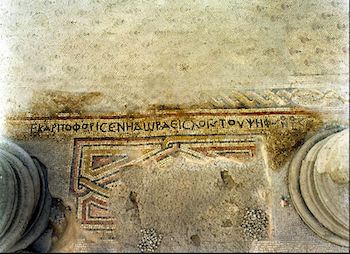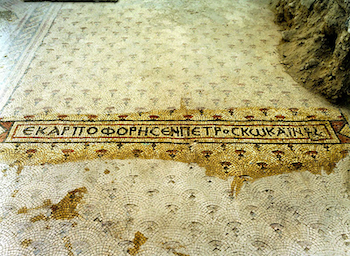See Also: First Season - 2000, Second Season - 2001, Fourth Season - 2003
By Arthur Segal
Head of the Project
Hippos Excavation Project
Zinman Institute of Archaeology
University of Haifa, Haifa
Michael Eisenberg
Asst. to Director
Hippos Excavation Project
Zinman Institute of Archaeology
University of Haifa, Haifa
March 2002
A. General
The third season of excavations at Sussita, undertaken by the Zinman Institute of Archaeology at the University of Haifa in cooperation with the Polish Academy of Sciences, was conducted throughout July 2002. The expedition was led by Prof. Arthur Segal, with Prof. Jolanta Mlynarczyk of the Polish Academy of Sciences and Dr. Mariusz Burdajewicz of the National Museum in Warsaw. This season we were joined by a team from the Theological Department of Concordia University, St. Paul, Minnesota, USA, headed by Prof. Mark Schuler.
B. Excavation Areas
In addition to the areas excavated during the previous seasons, two new areas were excavated. All together 4 areas were excavated during this season:
- The Hellenistic Compound
This excavation area includes mainly the area known from previous seasons as the "Northern Complex" and the other areas which were excavated within it and immediately adjacent to it. - The Northwest Church
This season the excavation of the church's main hall has been completed. The industrial complex (wine and oil presses) located to the south of the church was excavated as well. - The Northeast Church
This church is situated 50 m. East to the Northwest Church. Excavation there started this season. - The East City Gate
The main goal of the excavations at this area was to clear the debris which covered the structure and to expose the main features of the gate area.
C. The Hellenistic Compound
At the end of the third season, it became clear that the main component of this area was actually a Hellenistic compound (temenos) bounded on its western and southern sites by an imposing, beautifully built wall. About 40 m. of this solid, massively built wall has been exposed during this season. Although the excavation of this large Hellenistic compound is only just beginning, it is already clear that what we have here is an extensive sanctuary which also continued to fulfill its original religious function in later periods. This assumption is based on the additional find of architectural fragments originating from Roman building as well. In addition, the Northwest Church has been built upon the remains of both Hellenistic and Roman remains.
The impressive southern wall of the Hellenistic compound is noteworthy, especially for its excellent construction with its layers arranged with great care in a uniform pattern of headers and stretchers. The basalt ashlars have dressed margins which give the impression of order and unity.
What is important to mention here is the fact that so far very few Hellenistic structures were exposed in the Decapolis cities. Most of the architectural remains exposed in Gadara, Gerasa, Pella, or Scythopolis belong to Roman-Byzantine periods. The very fact that the Hellenistic Compound has been found in Hippos is in itself a very important contribution to the architectural history of this area of the Hellenistic-Roman world.
D. The Northwest Church
The main effort of the Polish team excavating the Northwest Church concentrated on exposing the southern aisle of the church. While cleaning the mosaic floor of the aisle, two Greek inscriptions were found. Those inscriptions were incorporated into the mosaic which covers the entire southern aisle of the Church.

One of the inscriptions is located in the intercolumnium between the second and the third column of the colonnade separating the main hall from the southern aisle. The one-line text reads as follows: Heliodora offered half of the nomisma for the costs of the mosasic.

The second inscription is found to the east part of the southern aisle and reads as follows: Petros offered half of the nomisma (---) for the costs of the mosaic.
The two inscriptions found in the church are votive texts commemorating the offering made by two pious members of the Christian community of Hippos who donated half of the nomisma each for the costs of the mosaic pavement in one of the local churches.
E. The Northeast Church
Approximately 50 m. to the east of the Northwest Church is another church which we named the Northeast Church. This structure has been excavated by a team from Concordia University, St. Paul, Minnesota, USA, headed by Prof. Mark Schuler. During this season, only the eastern part of the main hall including the apse has been partially excavated. In the southeast corner of the main hall, a sarcophagus half-buried in the church floor has been located.
It is our intension to continue the exploration of the Northeast Church in the next season.
F. The Eastern City Gate
During the 3rd season of excavations, it was decided to expose the remains of the eastern city gate located at the east end of the Decumanus Maximus.
The eastern gate of Hippos was incorporated into the city wall and situated at the east end of a cliff overlooking the saddle that links the mountain of Hippos to the east-western slopes of the Golan Heights.
The gate has one passageway with two towers on either side that protrude eastward from the wall.
The unique aspect of the eastern gate of Hippos is the lack of symmetry with regard to the placement of two towers in relation to the gate itself and the totally different plane of these towers.
The round tower, which is incorporated into the wall of the city, created a killing field opposite the gate itself facing towards the saddle and also towards the slope to the south of it. The square tower, on the other hand, which is placed at the edge of the cliff, does not create any real killing field except for the narrow space near the gate passageway.
The city wall of Hippos and the city gate itself are built of local basalt stone. The construction quality of the gate is significantly superior to that of the wall. The round tower itself is built from a relatively small-sized ashlar uniformly built of alternating layers of headers and stretchers without binding materials.
